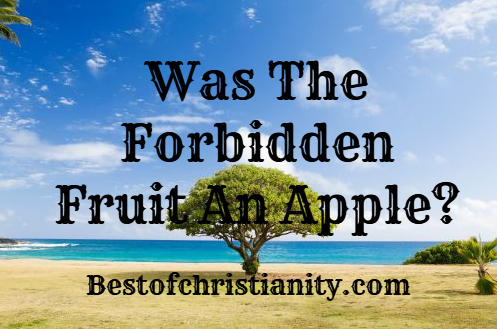
Was The Forbidden Fruit An Apple? In our society today, the phrase “forbidden fruit” has come to mean “something desirable but off limits.” It is from the Biblical account of the first man and woman, Adam and Eve, committing the first sin on earth that the idea of forbidden fruit originated. Genesis chapter 3 clearly gives an account of mankind’s first temptation which took place in the Garden of Eden. We read that Satan, who came in the form of a serpent, questioned and contradicted God’s words. He succeeded in convincing Eve that she had misunderstood God’s clearly stated command not to eat of the tree of knowledge of good and evil (Genesis 3:4–5). The Devil challenged Eve’s understanding of God’s words, suggesting that she should make her own decision based on her personal assessment that the forbidden fruit was “good,” “pleasing,” and ‘desirable” (Genesis 3:6).
Being deceived by Satan, and acting contrary to God’s command (Genesis 2:16–17), the first woman and wife of Adam, Eve ate from the forbidden tree. In the same way, she gave the forbidden fruit to her husband, Adam who ate as well. At that moment, sin, suffering, destruction, evil, and death entered God’s perfectly created world. Romans 5:12 says, “Therefore, just as sin came into the world through one man, and death through sin, and so death spread to all men because all sinned—” Remember what the Lord God told Adam in Genesis 2:17: “but from the tree of the knowledge of good and evil you shall not eat, for in the day that you eat from it you will surely die.” Sadly, Adam and Eve chose to disobey God by eating the forbidden fruit from the tree of knowledge of good and evil.
Was The Forbidden Fruit An Apple?
Throughout centuries, many people have wondered about the identity of this enticing fruit that caused so much trouble to humanity. Was it a banana? Or perhaps an apple as many people assume? The Hebrew word for “fruit” as used in the Biblical book of Genesis is Peri, which happens to be a generic term used for “result,” “produce,” or “reward.” Truthfully speaking, nowhere is the identity of the forbidden fruit given in Scripture. Some speculate that the idea of its being an apple may have begun when the Bible was translated into Latin. Notice that the Latin word for “apple” is mālum, which is similar to another Latin word, mălum, Thus, it could likely be that when the Latin Vulgate came into being, the similarity in words could have spawned the idea that apples represent evil.
In addition, legend and artwork have also added to the common assumption that the forbidden fruit in the Garden of Eden was an apple. We idiomatically refer to the larynx as Adam’s apple, a term that originated from a folk tale wherein the bulge in a person’s neck was caused by the apple sticking in Adam’s throat. (Helping the legend along is the fact that the cartilaginous protrusion is more pronounced in men than in women.) Furthermore, Renaissance painters helped affix the identification of the forbidden fruit as an apple through their depictions of Biblical stories mixed with mythology. Folklore tends to create a life of its own when people repeat as truth what began as a suggestion. However, there are reasons to believe that the fruit mentioned in Genesis 3 is no longer available on Earth same with the tree of life (Genesis 2:9; 3:24; Revelation 22:2).
Also Read
- Was Adam And Eve’s Sin Really About Eating A Piece Of Forbidden Fruit?
- What Is The Location Of The Garden Of Eden?
- Why Didn’t God Want Adam And Eve To Know Good From Evil?
- What Did God Say To Adam And Eve After They Ate The Apple?
- If God Knew That Adam And Eve Would Sin, Why Did He Create Them?
- Was Adam With Eve When She Was Speaking With The Serpent?
- What Does The Bible Say About Adam And Eve?
- What Is The Book Of Adam And Eve?
- Bible Verses About Righteousness
- Bible Verses About The Messiah
- What Does The Bible Say About Evil?
- What Does The Bible Say About Goodness?

